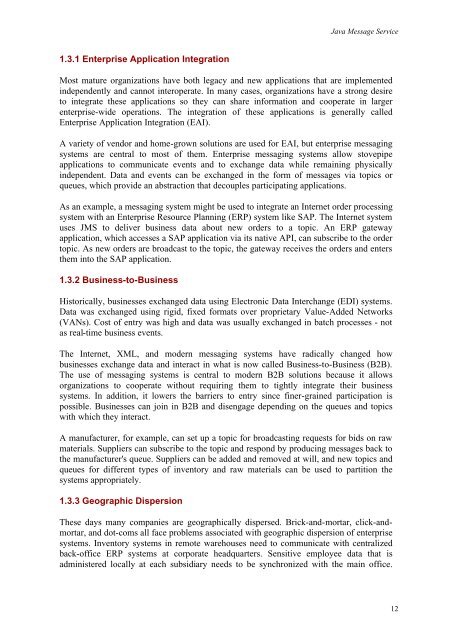O'Reilly - Java Message Service
O'Reilly - Java Message Service
O'Reilly - Java Message Service
Create successful ePaper yourself
Turn your PDF publications into a flip-book with our unique Google optimized e-Paper software.
1.3.1 Enterprise Application Integration<br />
<strong>Java</strong> <strong>Message</strong> <strong>Service</strong><br />
Most mature organizations have both legacy and new applications that are implemented<br />
independently and cannot interoperate. In many cases, organizations have a strong desire<br />
to integrate these applications so they can share information and cooperate in larger<br />
enterprise-wide operations. The integration of these applications is generally called<br />
Enterprise Application Integration (EAI).<br />
A variety of vendor and home-grown solutions are used for EAI, but enterprise messaging<br />
systems are central to most of them. Enterprise messaging systems allow stovepipe<br />
applications to communicate events and to exchange data while remaining physically<br />
independent. Data and events can be exchanged in the form of messages via topics or<br />
queues, which provide an abstraction that decouples participating applications.<br />
As an example, a messaging system might be used to integrate an Internet order processing<br />
system with an Enterprise Resource Planning (ERP) system like SAP. The Internet system<br />
uses JMS to deliver business data about new orders to a topic. An ERP gateway<br />
application, which accesses a SAP application via its native API, can subscribe to the order<br />
topic. As new orders are broadcast to the topic, the gateway receives the orders and enters<br />
them into the SAP application.<br />
1.3.2 Business-to-Business<br />
Historically, businesses exchanged data using Electronic Data Interchange (EDI) systems.<br />
Data was exchanged using rigid, fixed formats over proprietary Value-Added Networks<br />
(VANs). Cost of entry was high and data was usually exchanged in batch processes - not<br />
as real-time business events.<br />
The Internet, XML, and modern messaging systems have radically changed how<br />
businesses exchange data and interact in what is now called Business-to-Business (B2B).<br />
The use of messaging systems is central to modern B2B solutions because it allows<br />
organizations to cooperate without requiring them to tightly integrate their business<br />
systems. In addition, it lowers the barriers to entry since finer-grained participation is<br />
possible. Businesses can join in B2B and disengage depending on the queues and topics<br />
with which they interact.<br />
A manufacturer, for example, can set up a topic for broadcasting requests for bids on raw<br />
materials. Suppliers can subscribe to the topic and respond by producing messages back to<br />
the manufacturer's queue. Suppliers can be added and removed at will, and new topics and<br />
queues for different types of inventory and raw materials can be used to partition the<br />
systems appropriately.<br />
1.3.3 Geographic Dispersion<br />
These days many companies are geographically dispersed. Brick-and-mortar, click-andmortar,<br />
and dot-coms all face problems associated with geographic dispersion of enterprise<br />
systems. Inventory systems in remote warehouses need to communicate with centralized<br />
back-office ERP systems at corporate headquarters. Sensitive employee data that is<br />
administered locally at each subsidiary needs to be synchronized with the main office.<br />
12
















